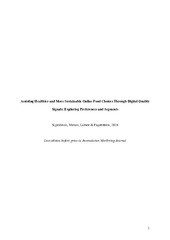Assisting healthier and more sustainable online food choices through digital quality signals: Exploring preferences and segments
Permanent lenke
https://hdl.handle.net/10037/33342Dato
2024-03-26Type
Journal articleTidsskriftartikkel
Peer reviewed
Sammendrag
The current paper contributes to signalling theory by demonstrating the importance of digital quality signals in influencing consumer preferences for sales and segmentation in the context of marketing fresh fish online. We conducted a choice-based conjoint analysis with a latent class segmentation to analyse the significance of digital quality signals compared to traditional attributes online. The analysis of 1,411 global consumers revealed that product rating was among the most important factors when purchasing fresh salmon fillets online. Latent class segmentation identified four distinct segments, the largest being ‘value for money’, where product rating and pricing were most important. The other segments were ‘environmentally friendly’, prioritising procurement methods and place of origin; ‘want it now’, where delivery was the most important factor; and ‘quality conscious’, which relied on three attributes – origin, delivery, and product rating. This study enhances understanding of the impact of socially mediated stimuli. It demonstrates the ability of digital quality signals to compensate for the absence of sensory evaluation in online store environments or deficiencies in knowledge or experience. The findings will benefit the food industry and online grocery retailers in promoting healthier and more sustainable products such as fish online.
Forlag
SAGE PublicationsSitering
Sigurdsson V, Menon VR, Larsen NM, Fagerstrøm A.F.. Assisting healthier and more sustainable online food choices through digital quality signals: Exploring preferences and segments. Australasian Marketing Journal. 2024Metadata
Vis full innførselSamlinger
Copyright 2024 The Author(s)


 English
English norsk
norsk